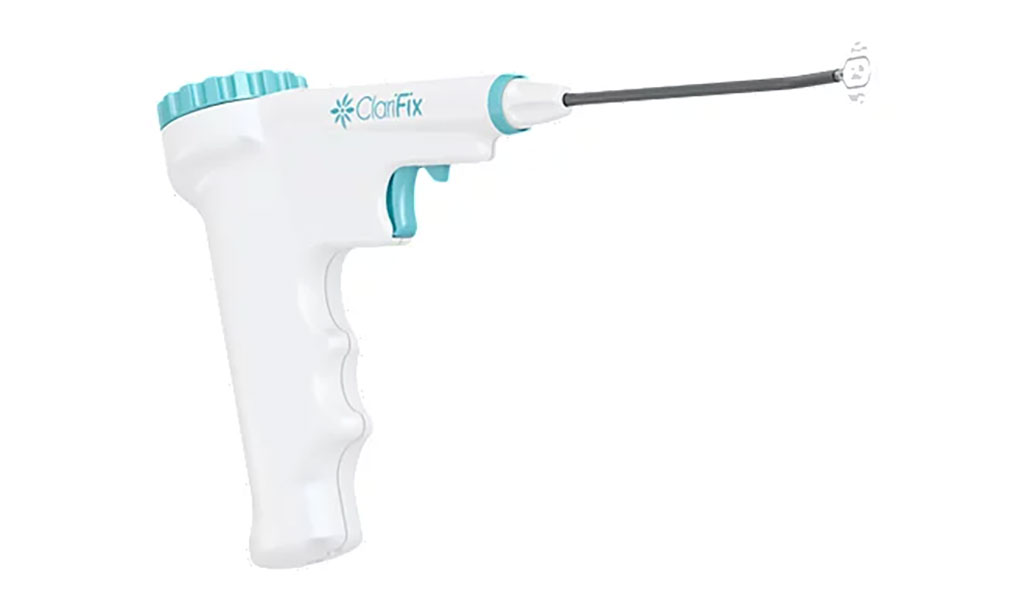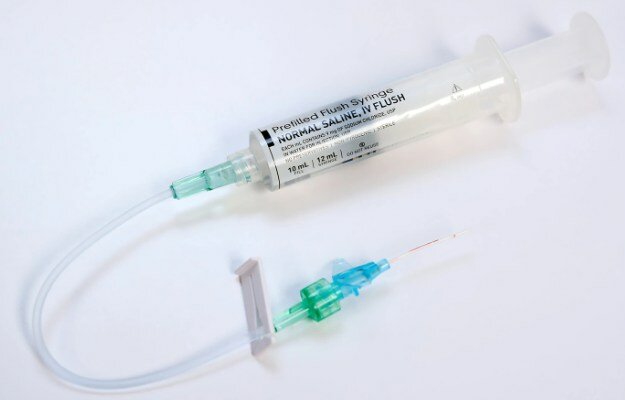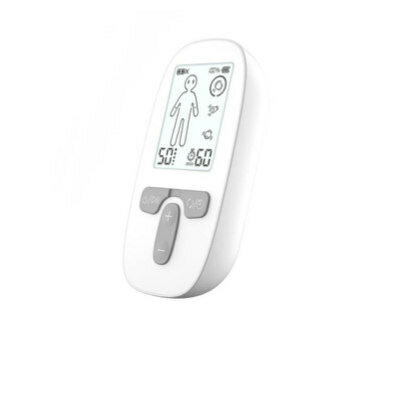Cryotherapy System Reduces Chronic Rhinitis Symptoms 
|
By HospiMedica International staff writers Posted on 06 Sep 2021 |

Image: The ClariFix cryotherapy device (Photo courtesy of Stryker)
A novel cryotherapy device freezes the posterior nasal nerve, thereby disrupting parasympathetic innervation of the nasal mucosa and reducing the symptoms of chronic rhinitis.
The Stryker Corporation (Kalamazoo, MI, USA) ClariFix cryotherapy device is a single patient-use, disposable cryosurgical device that consists of a handle attached to a cannula with a cryoprobe at the distal end. The handheld device is provided sterile, with two optional nitrous oxide (N2O) cryogenic canister sizes available. To perform cryosurgery, the desired cryogen canister is inserted into the ClariFix handle. A canister cap is then tightened onto the handle, piercing the canister. Once a mechanical valve is opened, cryogen flows down the cannula into the Cryoprobe.
The Cryoprobe is placed into contact with the targeted posterior nasal nerve via direct visualization, and can be rotated to ensure proper positioning. Once in the desired position, cryogen is released to flow into the Cryoprobe, partially evaporating to cool the Cryoprobe to -80°C. A freeze zone forms in the adjacent tissue, damaging the nerve. Once the area has been treated, cryosurgery is stopped by closing the valve. As soon as the Cryoprobe has thawed, it can be safely removed. Further cycles can be initiated per physician discretion.
Chronic rhinitis is a frequent inflammation of the nasal cavity with symptoms such as a runny nose, nasal congestion, and post-nasal drip. Symptoms of rhinitis include rhinorrhea (runny nose), nasal itching, nasal congestion, sneezing, and post-nasal drip, an accumulation of mucus in the back of the nose and throat leading to (or giving the sensation of) mucus dripping downward from the back of the nose.
Related Links:
Stryker Corporation
The Stryker Corporation (Kalamazoo, MI, USA) ClariFix cryotherapy device is a single patient-use, disposable cryosurgical device that consists of a handle attached to a cannula with a cryoprobe at the distal end. The handheld device is provided sterile, with two optional nitrous oxide (N2O) cryogenic canister sizes available. To perform cryosurgery, the desired cryogen canister is inserted into the ClariFix handle. A canister cap is then tightened onto the handle, piercing the canister. Once a mechanical valve is opened, cryogen flows down the cannula into the Cryoprobe.
The Cryoprobe is placed into contact with the targeted posterior nasal nerve via direct visualization, and can be rotated to ensure proper positioning. Once in the desired position, cryogen is released to flow into the Cryoprobe, partially evaporating to cool the Cryoprobe to -80°C. A freeze zone forms in the adjacent tissue, damaging the nerve. Once the area has been treated, cryosurgery is stopped by closing the valve. As soon as the Cryoprobe has thawed, it can be safely removed. Further cycles can be initiated per physician discretion.
Chronic rhinitis is a frequent inflammation of the nasal cavity with symptoms such as a runny nose, nasal congestion, and post-nasal drip. Symptoms of rhinitis include rhinorrhea (runny nose), nasal itching, nasal congestion, sneezing, and post-nasal drip, an accumulation of mucus in the back of the nose and throat leading to (or giving the sensation of) mucus dripping downward from the back of the nose.
Related Links:
Stryker Corporation
Latest Critical Care News
- Precision Approach Improves Immunotherapy Effectiveness for ICU Patients with Sepsis
- Soft Robots Could Donate Their Heart to Humans
- Bioadhesive Strategy Prevents Fibrosis Around Device Implants on Peripheral Nerves
- Miniature Non-Invasive Robotic Catheters to Improve Infertility Treatments
- Stick-On Patch Monitors Baby's Movements In Utero
- EEG-Based AI Technology Accurately Diagnoses Alzheimer’s and Dementia
- Robot Lymphatic System Paves Way for Self-Powered Wearables and Machines
- Focused Ultrasound Technique Successfully Treats Pediatric Brain Cancer
- Nasal Drops Fight Brain Tumors Noninvasively
- AI Helps Optimize Therapy Selection and Dosing for Septic Shock
- Glowing Bacteria ‘Pills’ for Detecting Gut Diseases Could Eliminate Colonoscopies
- Skin-Permeable Polymer Patch Delivers Insulin Non-Invasively Through Skin
- Nanogel Technology Almost 100% Effective in Destroying Drug-Resistant Bacteria Within Hours
- Wearable Ultrasound Sensor Delivers Noninvasive Treatment Without Surgery
- Gel-Free ECG System to Transform Heart Health Diagnosis
- Biodegradable Patch Repairs Damaged Tissue After Heart Attack
Channels
Surgical Techniques
view channel
Minimally Invasive Surgery Proven Safe and Effective for Complex ‘Whipple’ Procedure
Tumors of the pancreatic head often require a highly complex operation known as pancreatoduodenectomy or the Whipple procedure. This surgery involves removing multiple structures and creating several internal... Read more
Catheter-Based Procedures Offer Less Invasive Option for Treatment of Valvular Disease
Valvular heart disease, caused by tight or leaky valves between heart chambers, affects up to 10% of older adults and leads to more than 120,000 deaths globally each year. Traditional open-heart surgery... Read morePatient Care
view channel
Revolutionary Automatic IV-Line Flushing Device to Enhance Infusion Care
More than 80% of in-hospital patients receive intravenous (IV) therapy. Every dose of IV medicine delivered in a small volume (<250 mL) infusion bag should be followed by subsequent flushing to ensure... Read more
VR Training Tool Combats Contamination of Portable Medical Equipment
Healthcare-associated infections (HAIs) impact one in every 31 patients, cause nearly 100,000 deaths each year, and cost USD 28.4 billion in direct medical expenses. Notably, up to 75% of these infections... Read more
Portable Biosensor Platform to Reduce Hospital-Acquired Infections
Approximately 4 million patients in the European Union acquire healthcare-associated infections (HAIs) or nosocomial infections each year, with around 37,000 deaths directly resulting from these infections,... Read moreFirst-Of-Its-Kind Portable Germicidal Light Technology Disinfects High-Touch Clinical Surfaces in Seconds
Reducing healthcare-acquired infections (HAIs) remains a pressing issue within global healthcare systems. In the United States alone, 1.7 million patients contract HAIs annually, leading to approximately... Read moreHealth IT
view channel
EMR-Based Tool Predicts Graft Failure After Kidney Transplant
Kidney transplantation offers patients with end-stage kidney disease longer survival and better quality of life than dialysis, yet graft failure remains a major challenge. Although a successful transplant... Read more
Printable Molecule-Selective Nanoparticles Enable Mass Production of Wearable Biosensors
The future of medicine is likely to focus on the personalization of healthcare—understanding exactly what an individual requires and delivering the appropriate combination of nutrients, metabolites, and... Read moreBusiness
view channel
Philips and Masimo Partner to Advance Patient Monitoring Measurement Technologies
Royal Philips (Amsterdam, Netherlands) and Masimo (Irvine, California, USA) have renewed their multi-year strategic collaboration, combining Philips’ expertise in patient monitoring with Masimo’s noninvasive... Read more
B. Braun Acquires Digital Microsurgery Company True Digital Surgery
The high-end microsurgery market in neurosurgery, spine, and ENT is undergoing a significant transformation. Traditional analog microscopes are giving way to digital exoscopes, which provide improved visualization,... Read more
CMEF 2025 to Promote Holistic and High-Quality Development of Medical and Health Industry
The 92nd China International Medical Equipment Fair (CMEF 2025) Autumn Exhibition is scheduled to be held from September 26 to 29 at the China Import and Export Fair Complex (Canton Fair Complex) in Guangzhou.... Read more













